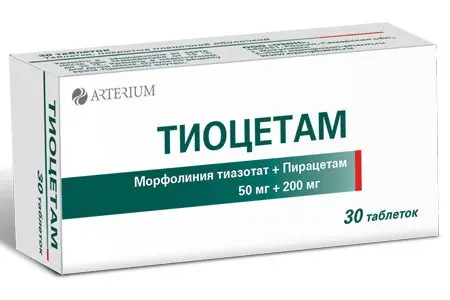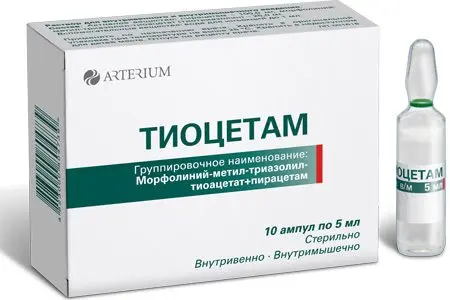Contents
- Important difference between Thiocetam and Piracetam
- Indications for use of Thiocetam
- Thiocetam release form and doses
- Side effects
- Contraindications for use
- Application in pregnancy and lactation
- Application for violations of kidney function
- Use in children
- Use in elderly patients
- special instructions
- Overdose
- Thiocetam drug interactions
- Pirocetam drug interactions
- Conditions of leave from pharmacies

Piracetam is a drug that affects the brain. This nootropic facilitates the transmission of nerve impulses in the brain. Piracetam is part of the drug Thiocetam.
Thiocetam contains thiotriazoline in addition to piracetam. This component prevents brain damage by active oxygen and free radicals.
Thiocetam is able to positively affect memory and attention. In addition, it affects the vascular wall, platelets and red blood cells, increasing the blood supply to the brain and the nutrition of nerve cells. It is also often used to treat chronic headaches. The drug can be used in patients with chronic cerebrovascular accident (including those who have had a stroke), as well as in those suffering from diabetes mellitus complicated by encephalopathy.
Important difference between Thiocetam and Piracetam
Thiotriazoline and piracetam enhance the positive therapeutic effect and reduce each other’s side reactions.
Unlike Piracetam, Thiocetam does not stimulate mental processes. This is due to the low dose of piracetam in the composition of Thiocetam. Reduce the dose of this component, eliminating unwanted reactions, allows thiotriazoline: it enhances the effect of piracetam. Therefore, piracetam with thiotriazoline in minimal dosages as part of one drug has a stronger therapeutic effect than piracetam alone.
Indications for use of Thiocetam

Thiocetam is indicated for such conditions as:
chronic ischemia of the brain, for example, in old age. The lack of blood circulation in this case is associated with vasoconstriction due to atherosclerotic plaques, which leads to frequent headaches;
the consequences of a stroke (during the recovery period);
diabetes mellitus complicated by encephalopathy;
chronic headaches associated with circulatory disorders in the brain.
Thiocetam release form and doses
Both piracetam and thiocetam are available in two forms: tablets and ampoules with a solution for intravenous or intramuscular administration.
The composition of 1 ml of the drug Tiocetam includes 100 mg of piracetam and 25 mg of thiotriazoline. Injection medicine is administered in case of impossibility of oral administration or with severe pathology. The course of injections is prescribed for 2 weeks. After it, you need to take Thiocetam in tablets.
One tablet of Thiocetam contains 200 mg of Piracetam and 50 mg of Thiotriazoline. The medicine is taken 30 minutes before meals. The last time the drug is desirable to take no later than 5 pm.
The dose of drugs is selected depending on the cause of impaired blood circulation in the brain.
Side effects

When taking these drugs, the following side effects may occur:
insomnia, exacerbation of epilepsy, impaired consciousness, nervous irritability, dizziness, imbalance, hallucinations, tinnitus, anxiety;
palpitations, rhythm disturbance, hypertension, heart pain;
abdominal pain, vomiting, diarrhea;
anaphylactic shock, rashes, itching, fever, angioedema;
weight gain;
shortness of breath, suffocation;
soreness at the injection site.
It is important that Thiocetam is devoid of such a side effect as a pronounced stimulating effect on the nervous system, which is characteristic of Piracetam.
Contraindications for use
These drugs are contraindicated in the following conditions:
hemorrhagic stroke;
hypersensitivity to components;
mental or motor excitement;
pregnancy and the period of breastfeeding;
severe impairment of kidney function;
age of 18 years;
Chorea of Huntington.
Application in pregnancy and lactation
These drugs are not recommended for use during gestation and lactation.
Application for violations of kidney function
In severe renal failure (creatinine excretion rate less than 20 ml / min), the drug is contraindicated. When removing creatinine from 20 to 80 ml / min, Piracetam and Thiocetam should be used with caution.
Use in children
Thiocetam and Piracetam are not recommended for children.
Use in elderly patients
The elderly require caution when prescribing drugs. These patients are more likely to experience adverse reactions. With prolonged use of the drug, it is necessary to monitor renal function and adjust the dose depending on the degree of creatinine excretion.
special instructions
During the period of therapy, it is recommended to refrain from work that requires increased attention. This includes driving a car.
Overdose
Overdose may cause or increase the side effects of drugs. Treatment requires discontinuation of drugs and symptomatic therapy.
Thiocetam drug interactions
It must be taken into account that the drug cannot be prescribed if the patient is taking thyroid hormones due to possible side effects: insomnia, impaired consciousness and agitation of the psyche. Thiocetam enhances the effect of painkillers and antidepressants. It is forbidden to take Thiocetam with products that have an acidic pH.
Pirocetam drug interactions
Piracetam is almost completely excreted by the kidneys. Drug interactions of this drug are most likely when used together with antiplatelet agents, neuroleptics, antiepileptic and psychotropic drugs.
Conditions of leave from pharmacies
Thiocetam and Pirocetam are available by prescription.
Thiocetam is a combined drug that improves cerebral circulation in various conditions. It eliminates frequent headaches, improves memory, attention, fights asthenia. The drug is devoid of the side effects of piracetam, and the combination with thiotriazoline allows you to achieve the maximum effect even with minimal doses of the drug’s components.









